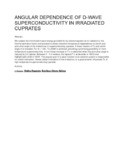| dc.contributor.author | Munasia, E | |
| dc.contributor.author | Rapando, Wakhu | |
| dc.contributor.author | o Ndinya, Boniface Otien | |
| dc.date.accessioned | 2021-12-31T09:19:22Z | |
| dc.date.available | 2021-12-31T09:19:22Z | |
| dc.date.issued | 2020-11 | |
| dc.identifier.uri | https://www.researchgate.net/publication/347890615_ANGULAR_DEPENDENCE_OF_D-WAVE_SUPERCONDUCTIVITY_IN_IRRADIATED_CUPRATES | |
| dc.identifier.uri | http://ir-library.mmust.ac.ke:8080/xmlui/handle/123456789/1981 | |
| dc.description.abstract | We subject the minimized d-wave energy provided for by electromagnetic (e.m) radiation to the thermal activation factor and proceed to obtain transition temperature dependence on zenith and azimuthal angle of the d-electrons in superconducting cuprates. A linear relation of Tc and zenith angle ∅ is revealed. For ∅ = 1.68 , Tc=300K is achieved, providing a promising possibility of room temperature superconductivity. A non-linear increase in T c is observed when the azimuthal angle is reduced to 0.4 radians. Between 0 − 0.4 radians, the highest T c achievable in YBCO and HgBa2Ca2Cu3O8 is 160 K. The angular part of a wave function of an electron system is responsible for orbital orientation. Hence orbital orientation of the d-electron, to a great extend, influences Tc of high temperature superconducting cuprates. | en_US |
| dc.language.iso | en | en_US |
| dc.publisher | IJRAR | en_US |
| dc.subject | ANGULAR, DEPENDENCE, D-WAVE, SUPERCONDUCTIVITY , IRRADIATED, CUPRATES | en_US |
| dc.title | ANGULAR DEPENDENCE OF D-WAVE SUPERCONDUCTIVITY IN IRRADIATED CUPRATES | en_US |
| dc.type | Article | en_US |

